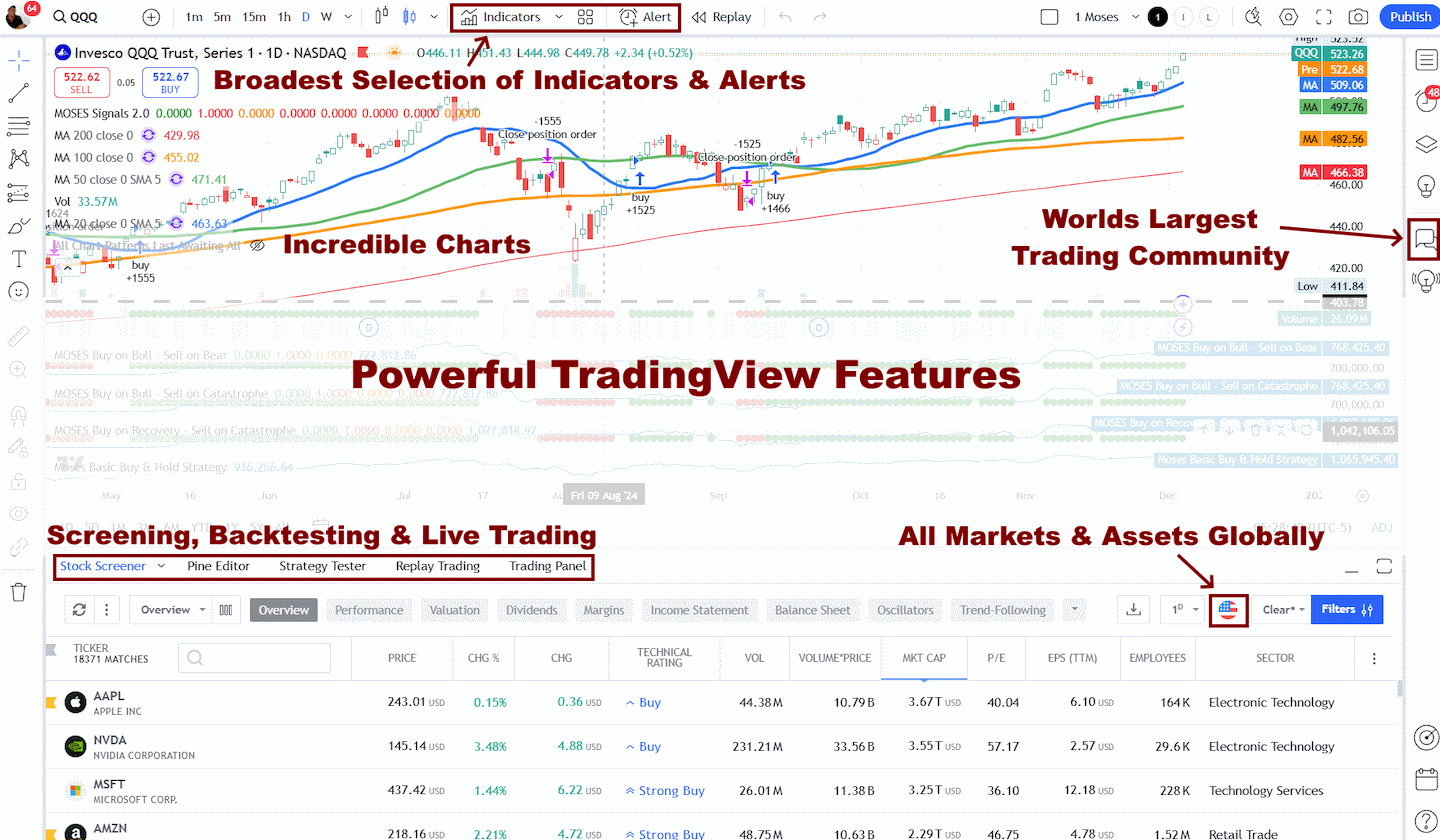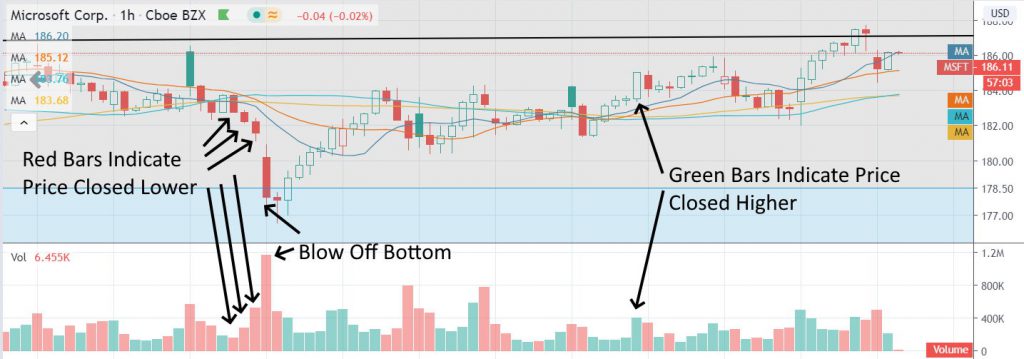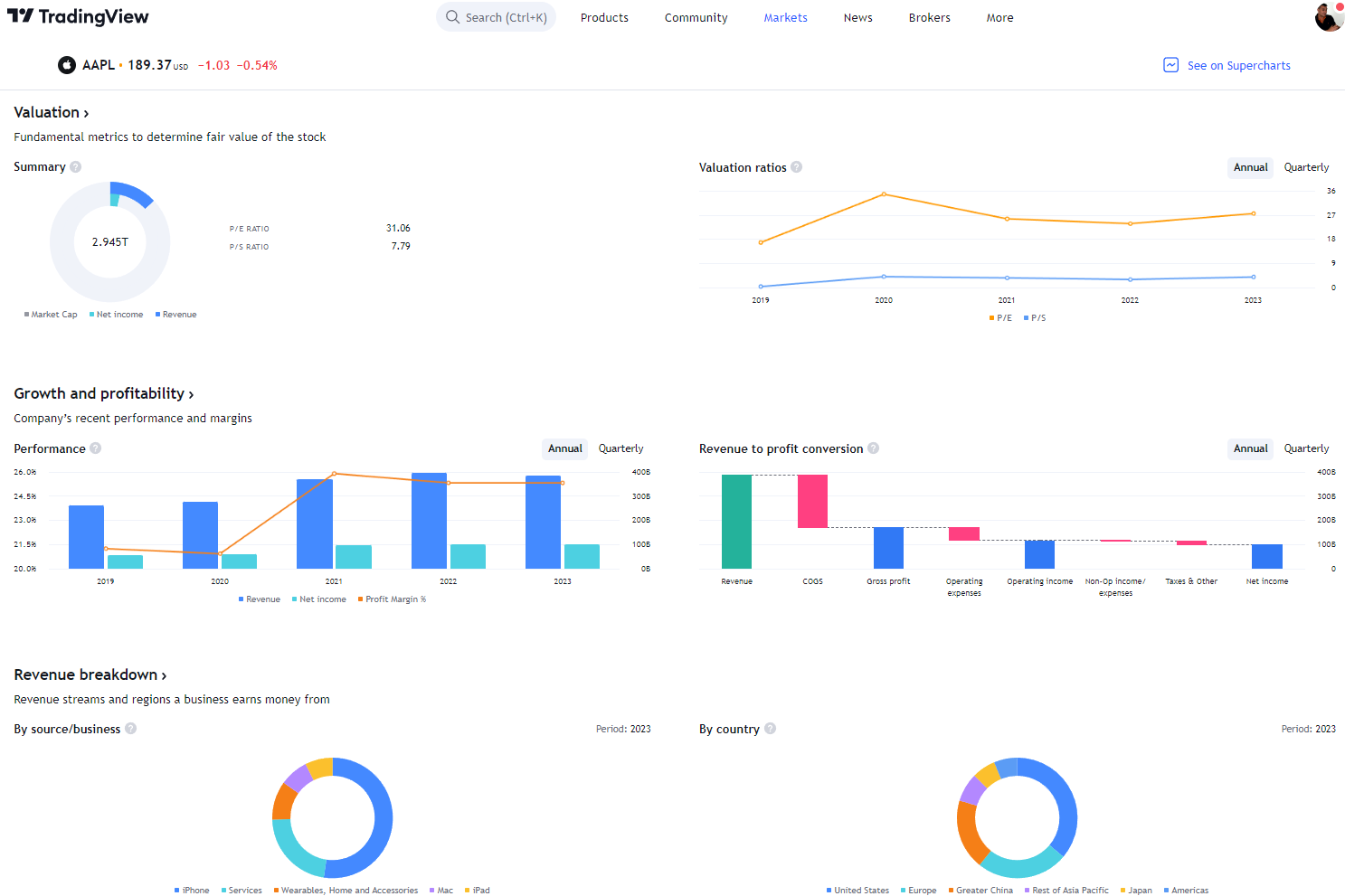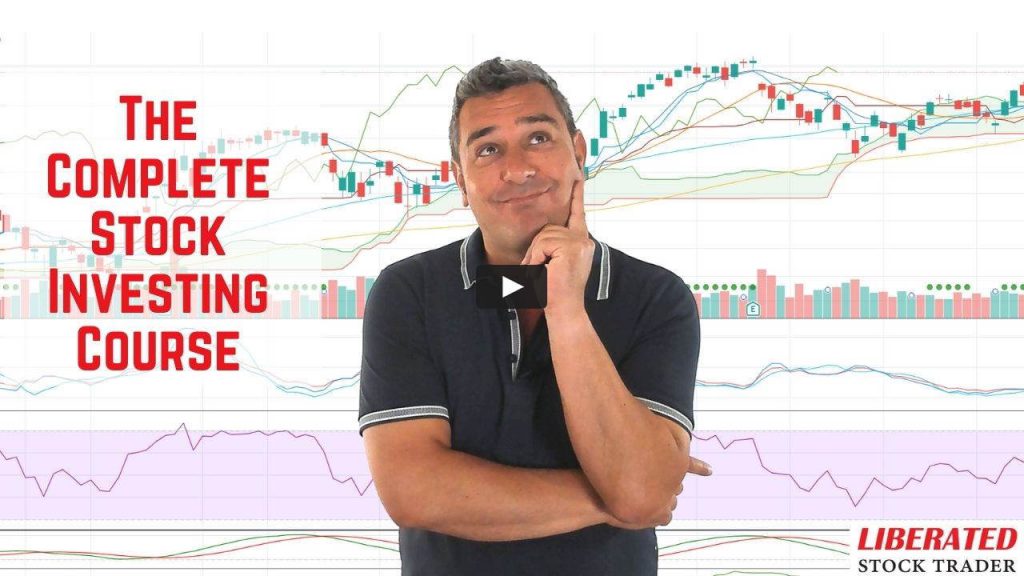Stock volume, or trading volume, is the total number of shares traded during a specific period. Volume indicates buying and selling pressure and potential changes in a stock’s trend direction and quality.
Market analysts use volume as one of the most crucial stock chart indicators to assess a given stock or index’s supply and demand.
Stock volume measures the number of shares traded and indicates market strength. Rising markets with increasing volume are viewed as bullish, and falling prices on higher volume are bearish.
The difference between supply (selling) and demand (buying) is what makes asset prices move.
This article will give you the critical knowledge to help you interpret stock price action.
What is Stock Volume?
Stock Volume is the number of shares or contracts traded during a particular period. It is an important technical indicator and provides insight into investor sentiment.
The higher the volume, the more actively traded a security is and usually indicates strong market demand for it.
On the other hand, the low volume suggests a lack of interest in the equity.
Volume can also be used to confirm price movements, as a large increase in volume usually indicates that a major move has happened or could soon happen.
In short, a stock’s volume is the number of shares exchanged between a buyer and a seller. Stock volume is the count of shares traded, not the dollar value of the shares exchanged.
What is the Volume in the Stock Market?
On average, in 2022, 50 billion stocks were traded monthly, and the total number of shares traded was over 650 billion for the S&P 500 index. During stock market volatility, for example, in 2008, the volume of stocks traded topped 1.3 trillion for the year.
What is Stock Volume?
Stock volume refers to the total number of shares traded. If 2 million shares are traded daily, the trading volume is 2 million. This means that 2 million stocks change hands from buyer to seller. It is not the total value of the stock traded but the number of shares traded.
The Volume indicator on a stock chart is usually expressed as a series of vertical bars on the X-axis of a chart. If 20,000 shares were traded, then the bar will show 20,000. The changes in volume from day to day indicate that a stock is more in demand if the volume bar rises and the stock price increases or less in demand if volume drops on price decreases.
Is the Volume Indicator Important?
Yes, volume indicators in stock analysis are important. The importance of stock volume cannot be overstated because it provides valuable insight into the underlying strength or weakness of stock price trends.
Volume gives investors an indication of market liquidity and an understanding of how actively the stock is being traded. When multiple trades happen during a short period, it could indicate that the stock is heavily sought after and popular among investors.
When trading activity drops, it could indicate a decrease in interest in the stock. Volume is important to traders and investors because it can identify potential breakouts or breakdowns in a security’s price and help confirm technical patterns on a chart.
My thorough testing awarded TradingView a stellar 4.8 stars!
With powerful stock chart analysis, pattern recognition, screening, backtesting, and a 20+ million user community, it’s a game-changer for traders.

Whether you're trading in the US or internationally, TradingView is my top pick for its unmatched features and ease of use.
Explore TradingView – Your Gateway to Smarter Trading!
Why is monitoring stock volume important?
Monitoring volume is essential for evaluating the strength of market moves because it suggests how much conviction there is behind the price action. With this information, traders can adjust their strategies accordingly. For example, if a stock’s volume increases significantly during an uptrend, it could indicate that the trend will continue and should be watched closely for potential buy opportunities. On the other hand, if a security’s volume decreases significantly during a downtrend, it could indicate that the trend may be losing momentum and should be watched closely for potential sell opportunities.
Combining the stock price movement with the increases or decreases in volume provides insight into the market participants’ supply, demand, and sentiment. Important volume indicators are Volume Bars, Equivolume, and Volume at Price.
For example, if the stock price increases and the volume decreases, fewer people are buying at this higher price. This means a change in demand and a potential change in the direction of the stock price.
Stock Chart Volume Color
Volume bars on a stock chart can be configured to be either red or green. The bar’s color indicates if there was a positive volume or negative volume for the period. A red volume bar indicates that the close price for the period was lower than the open price. A green volume bar indicates that the close price exceeded the open price.
What is Green Volume on Stock Charts?
If you see a green volume bar in a stock chart, it means that the stock price for the selected period has a close price higher than the open price. This means the volume was positive; the stock’s demand exceeded supply, pushing the price up. Multiple green volume bars are a bullish indicator.
What is Red Volume on Stock Charts?
If you see a red volume bar in a stock chart, it means that the stock price for the selected period has a close price lower than the open price. This means the volume was negative, and the stock supply exceeded demand, pushing the price down. Multiple red volume bars are a bearish indicator.

Stock Chart Volume Color Example.
Look at the chart above for Microsoft Corp. (MSFT). Please closely examine volume and price and what they have in common.
The volume indicator is configured to show a RED Bar if the closing price for the stock is lower than the opening price, meaning “Negative Volume,” and green for days where the closing price is higher than the opening “Positive Volume.”
Volume in Stock Charts
Reading volume in stock charts is simply understanding supply and demand. A high volume when a stock price increases means the stock is currently undervalued and is in demand. High volume on stock price decreases means that the stock might be overvalued and is under selling pressure.
Sometimes, the volume indicator bar is so large that it usually indicates a change in the stock price trend; this brings us to the topic of “Blow-off Volume.”
What do you see in the Volume Chart?
- What happened to volume when the price changed?
- What happened to the price when the volume spiked?
What is a blow-off top in a stock chart?
A blow-off top is a phenomenon seen in stock charts when an asset experiences a rapid and steep rise in price, followed by a sudden and dramatic drop. This is usually caused by large numbers of investors selling their shares, which drives the price down quickly and dramatically. The term “blow off top” derives from the idea that the price had been going up but suddenly “blew off” due to the large amounts of selling.
The blow-off top is often seen near the end of a long-term uptrend and can be used by traders to indicate that a market may be about to reverse its trend. Traders must be cautious when trading around such events, as the price may continue to drop sharply.
A blow-off top can indicate overbought market conditions and a potential sell opportunity.
What is a blow-off bottom in a stock chart?
A blow-off bottom occurs when an asset suddenly experiences a rapid and steep drop in price, followed by a sudden and dramatic rise.
This is usually caused by many investors buying a stock simultaneously, which drives the price up quickly and dramatically.
The term “blow off bottom” derives from the idea that the price had been going down but suddenly “blew off” due to the large amounts of buying. The blow-off bottom is often seen near the end of a long-term downtrend and can be used by traders to indicate that a market may be about to reverse its trend.
How to Read Volume in a Stock Chart.
To read volume in a stock chart, you need to evaluate the stock price trend, look for spikes in volume, and then see if the price trend has changed after the volume spike.
Look at the chart below and read further for a description of the key concepts. The chart maps Price, Moving Averages 10 & 30, and Volume (Red for Negative, Green for Positive).

1. Look at Price Direction & Volume Levels
Price Direction Changes Upwards, Surge In Volume
Here, at point 1, we see a huge change in the price direction; it was proceeding downward, and then suddenly, there was a spike in volume over two weeks, known as a “blow-off bottom.”
It indicates that a key price has been found, where the sellers have lost enough that they need to sell the stock, and the buyers have seen the price decrease enough to see real value in the stock. Of course, other factors contribute, like good news or earnings results. Whatever happened, the volume increased!
2. Observe if Price Direction Changes on Increased Volume
Price Direction Change Down, Surge In Volume
The stock here increases from $20 to $38 in the following three months, a 90% increase, but how would we know this was about to happen? Buying when the moving averages crossed over would have been a good option; it would not have provided the full 90%, but it would have produced 40%, which is an excellent result. However, we see a monster, Blow off Top, the huge red Spike; this is a powerful sign to sell as soon as possible.
From stage 2, we see the stock move in a sideways pattern and eventually decrease to $19; the ride is well and truly over. However, you would not own the stock, as you would have sold when the moving averages crossed. The stock price started to increase in mid-November 2008, but volume tells us nothing.
WHY? Indicators do not tell us something 100% of the time, but we need to recognize it when they do. The moving averages cross at $25, a good time to buy.
3. Look for High Volume and Price Increases
Huge Volume and Price Increasing
Our chart below shows massive buying; the volume goes through the roof. It is important to note that we are comparing the stock’s volume to its history. This is the second biggest volume surge of the year for Netflix and is significant.
Why did it take off? We should always seek enlightenment!
It reported excellent earnings, and because of the recession, people switched from buying bigger ticket items such as Cars and Plasma TVs to staying at home and renting movies. Netflix reported a massive increase in new members.
The chart below shows that the price “Gapped Up.” What does this mean? The stock price in extended-hours trading was so strong that the opening price on the following day was significantly higher than even the high price for the previous day, thus showing a gap in the chart’s price pattern.
Warning: Some volatile stocks show many price gaps. While price gaps might sound good when they gap upwards, they are terrible if they gap down against you. Avoid stocks with any history of strong negative gapping, as gaps do not allow you to sell at the price you want to.
Volume is important, and reading it should become second nature. When searching for winning stocks, we should ideally look for stocks with increased volume to have a better chance of a quicker, less risky win.
A volume chart will always show red bars when the stock price has decreased for the day and green bars when the price has risen.
The 4 Best Volume Indicators
Modern technical analysis software has four excellent volume indicators: volume bars, volume profile, VWAP, and vertical volume. Which one is the best depends on what you are looking for.
1. Stock Market Volume Bars
The Volume Bar Chart visualizes the supply and demand for a given stock at a specific minute, hour, day, week, or month. It is the most commonly used volume indicator in the technical analysis of stocks and commodities.
2. Volume Profile HD Indicator.
The best supply and demand TradingView indicator is the Volume Profile HD. Used on a 5-minute intraday setting, you can see the volume profile for each trading session. This is a unique and powerful volume indicator.
Try Volume Profile on TradingView.
This indicator allows traders to analyze the volume at a certain price level, helping them identify strong buying and selling areas. Volume Profile plots the total volume executed at each price level. This gives traders an idea of where the most activity occurs, which helps them make more informed trading decisions. Additionally, the Volume Profile indicator can identify strong support and resistance levels that may not be apparent on a normal volume chart. This makes it an invaluable tool for traders looking for strategic entry and exit points in their trades.
Overall, the Volume Profile indicator is one of the best indicators available on TradingView for analyzing supply and demand. It gives traders valuable insights into price movement and volume activity, giving them a distinct edge in their trading decisions. This indicator can be an invaluable tool for making more profitable trades by providing an accurate read of market sentiment.
3. VWAP Indicator
The Volume Weighted Average Price (VWAP) indicator is one of the best volume indicators available on TradingView. This indicator provides traders with a powerful tool to identify entry and exit points for their trades based on the volume of trading activity. VWAP plots the cumulative total by comparing the price and volume of trades over a given period.
It plots the cumulative total of price and volume over a given period, allowing traders to identify entry and exit points for their trades easily. VWAP helps traders analyze support and resistance levels and overhead supply and demand, which may not be evident on a chart. This indicator is particularly useful for intraday analysis as it can indicate the overall trend of the period; when the price is above the VWAP, the trend is up. When it’s below the VWAP, the trend is down. There can be a lag between the indicator and price due to VWAP’s calculation of an average from past data.
4. Vertical Volume + Session Volume Profile
The vertical volume indicator is important for traders to gauge the strength or weakness of a given stock. On TradingView, it is one of the standard indicators used to assess supply and demand in a market.
The vertical volume indicator displays the buying or selling activity amount in a given time frame, helping traders quickly identify supply and demand. This indicator can be an additional confirmation signal for trade entry and exit points and is also useful in identifying divergences between price and volume.
When you combine the standard vertical volume bars and the Session Volume Profile, you get a 360-degree view of supply at any time frame at any price.
You want to be a successful stock investor but don’t know where to start.
Learning stock market investing on your own can be overwhelming. There’s so much information out there, and it’s hard to know what’s true and what’s not.
Liberated Stock Trader Pro Investing Course
Our pro investing classes are the perfect way to learn stock investing. You will learn everything you need to know about financial analysis, charts, stock screening, and portfolio building so you can start building wealth today.
★ 16 Hours of Video Lessons + eBook ★
★ Complete Financial Analysis Lessons ★
★ 6 Proven Investing Strategies ★
★ Professional Grade Stock Chart Analysis Classes ★
What Does High Volume Mean in Stocks?
High volume in stocks can mean two things. High volume when the price decreases means there are more sellers than buyers, which is a sell-off. High volume when the stock price is going up means there is a rally in the stock price, meaning there are more buyers than sellers, which increases demand and pushes the stock price up.
What is a Good Volume for a Stock?
A good volume for stocks is at least $1 million traded daily. That means Stock Price * Volume = $ Volume Traded. There is another easy way to see if a stock has enough volume. There is not enough liquidity if you see large gaps between the open and closing price for any stock. This means there is not enough volume for good liquidity.
Penny stocks often do not have enough volume. For example, if the stock price is $1 and the volume is 5,000, that means only $5000 of stocks is traded in a single day; that is not a fair and equitable market.
Golden Supply & Demand Rules
Volume and price have important characteristics. The direction of price movement compared to increases or decreases in volume is everything. In short, it is about buyers and sellers.
1. Price Up & Volume Up (PUVU)
Stock Price moves higher on increased volume. This is bullish as it shows us that more participants are interested in selling the stock at higher prices, and most importantly, more people are interested in buying the stock at those higher prices. In an uptrend, this signals the trend will continue; in a downtrend, this signals a possible correction or change in the trend’s short-term direction to upwards.
2. Price Up & Volume Down (PUVD)
In an uptrend, this is very bearish as it suggests that although prices are rising, fewer participants suggest that people are backing away from the higher prices. This also infers that the trend is weakening. In a downtrend, it suggests a continuance of the downtrend.
3. Price Down & Volume Up (PDVU)
In a downtrend, this signals that a change in trend is likely; as we saw with the “Blow off bottom,” there might be a huge selling climax, then the trend adjusts from down to sideways or down to up. In an uptrend, this may indicate a crisis, panic selling, or simply when a stock is going out of favor. The pressure is on the sell side, and they have to accept lower prices to sell. A strong negative signal!
4. Price Down & Volume Down (PDVD)
This suggests that the retreat is slowing or beginning to end in a downtrend as fewer people are interested in buying or selling the stock at these prices. In an uptrend, this may indicate the stock is stopping for a breath or due to a pullback before continuing on its upward trajectory. Volume tends to trend in the same direction as the price trend, so PDVD also suggests a continuation of the main downtrend or a pullback and a possible continuation of an uptrend.
So you see, the price and the direction of both price and volume are important. This is where the Price Volume Indicators play an important role.
Check out our PRO Training for the most comprehensive training on all major stock chart indicators and technical analysis.
Try TradingView, Our Recommended Tool for International Traders
Global Community, Charts, Screening, Analysis & Broker Integration

Global Financial Analysis for Free on TradingView
FAQ
How does volume affect stock price?
Volume plays an important role as it indicates the number of shares being traded. A high volume on decreasing prices suggests a stock is overbought and may decrease, and a high volume on increasing prices suggest traders think the stock is undervalued.
What is a good volume for stocks?
A stock with an average daily trading volume of 2 million on a stock price greater than $3 will usually qualify as having a healthy and active market. Low volumes indicate low demand from buyers, which could mean that current prices may not be sustained.
What does low volume mean in stocks?
Low volume in stocks indicates little interest from traders and investors. This could mean that current prices may be unsustainable, as the lack of buying and selling pressure makes it difficult for stocks to hold onto their gains. Low volume could also mean that the stock is not actively traded, which may mean it is not as liquid and easily tradeable, so avoid those stocks.
Is stock volume in shares or dollars?
Stock volume is usually measured in shares traded, not dollars. This is because the volume reflects how many shares of stock were bought and sold during a certain period and not the total value of those trades.
Does high volume increase the stock price?
High volumes of stock trading can influence the price of a stock, as it demonstrates strong buying or selling pressure which could push prices higher. However, high volume does not guarantee an increase in stock price; rather, it suggests that the market is either bullish or bearish about a particular stock.
Does volume matter in stocks?
Yes, volume matters in stocks because it is a key indicator of investor sentiment. Volume reflects how many shares of stock were bought and sold during a certain period which can provide insight into whether the market is bullish or bearish about the stock's prospects.
How important is the volume in stock?
Volume is considered the second most important indicator in technical analysis. The most important indicator is the stock price. By combining the stock price trend and the increase or decrease in volume, the trader can gauge the market's supply and demand for a stock.


Thank you, helpful.
Great explanation. Giving more graphical examples make better understanding
The ‘GAP UP” info was VERY enlightening, thanks so much for a great article. (But please, start using brighter charts which us older people can see
Hi RAC, thanks for the feedback. Hey I never thought about the dark charts. It is great input, I will change it for future posts Thanks for the advice, I am getting older myself now too.
hi Barry,
Same thing happened with me as with Clarence, couldn’t understand a word the other guy wanted to say but I think I got something big out of your post. Thanks for your post.
Just happened across your site.
I agree, Volume is greatly underestimated by most traders and gives a very important edge to those that understand its value.
Keep up the good work. I will toddle of and have a look at the rest of your site.
Regards
David
I have understand it better.Thanks.
I saw something similar to this on another website and didn’t really understand it, but your post helped me understand it better. Cheers!
the pleasure is all mine Clarence
Hi Clarence, thanks for the feedback it is always nice to see the effort helped someone